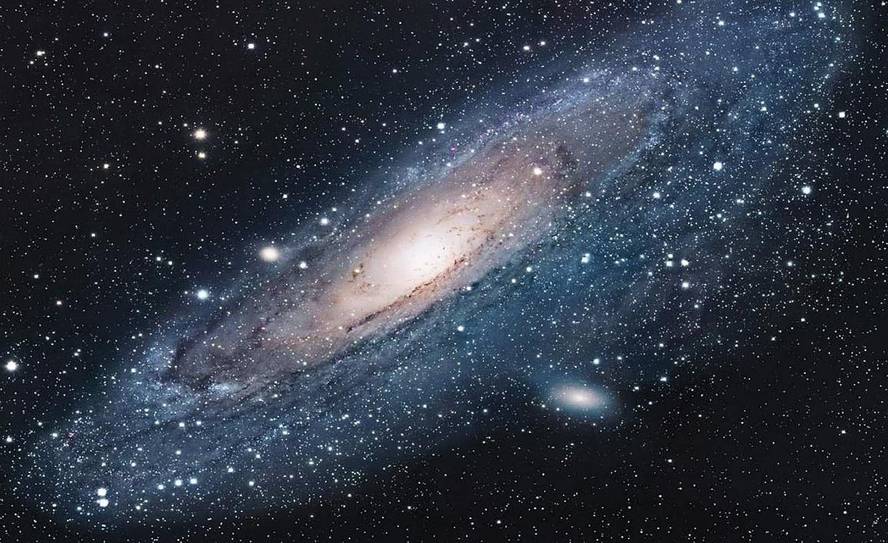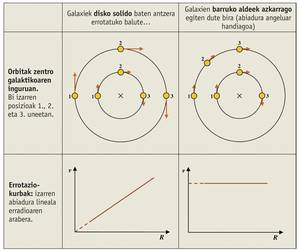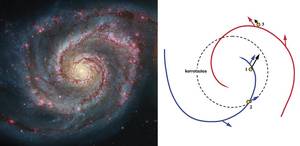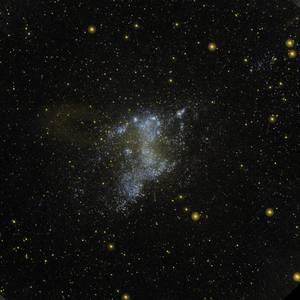Mysterious rotation of spiral galaxies
Madrilgo Unibertsitate Konplutentseko Astrofisikako ikaslea (UCM). Kanarietako Astrofisika Institutuko udako ikerketa-bekaduna (IAC)

We could say that everything is moving in the universe, that every body revolves around something else: We know that the Moon around the Earth, the Earth around the Sun, and that all the stars of the Milky Way, including our Sun, move around the galactic center. In this cosmic dance, the rotation of spiral galaxies caused a great surprise. In twentieth-century astrophysics, and today, many astrophysicists spend hours measuring and explaining exactly this phenomenon.
The spiral "nebulae" were called to Charles Messier and other celestial cartographers in the XVIII. In the twentieth century. However, until about a hundred years ago it was not possible to prove that these objects are a gigantic set of stars far from our Milky Way. In fact, in 1925 the American astronomer Edwin Hubble made it clear that these entities like clouds are outside our galaxy. For this purpose he used as laboratory the galaxies NGC 6822 and M31, still known at that time as "spiral nebula". By tracking a special type of star (cefeid stars) that changes brightness in a given way, he calculated the distance to those nebulae; comparing this distance with the size of the Milky Way, he concluded that these objects are outside our own galaxy, hundreds of times farther than the stars we can see at night.
Therefore, spiral galaxies that we can see through telescopes are independent of our Milky Way, sets of millions of stars, such as the "island of the universe". Consequently, the rotation of spiral galaxies is an essential phenomenon: if these galaxies had no rotation movement, they would collapse and disappear by gravity. Let's see what happens to us by car when we give a curve. Turning with the car, our body moves out, following the direction it was at first (that impulse we feel in physics is called centrifugal force). The same applies to galaxies: if the stars do not move, the gravitational attraction would compress and remove the galaxy (as the Earth attracts us), while if the stars revolve around the center of the galaxy, the centrifugal force out can avoid collapse. Therefore, it is quite natural that galaxies have a rotation movement and astronomers expected this movement to be detected in some way.
The islands of the universe turn
At first, scientists thought that spiral galaxies spin like a solid disk. According to this intuitive model, rigid spiral arms of matter would always be formed by spontaneous stars, and would not alter their shape over time: they would remain firm and always turn. Galaxies would make rotation as if we took the photo of a spiral galaxy today and turned on an axis that passes through the center. However, galaxies need hundreds of millions of years to perform a single rotation, so the change of position of stars is impossible in our short lives.

The first quantitative measurements on the rotation of galaxies were performed using the Doppler effect. This effect allows to determine the speed of each point of the galaxy compared to the viewer, since there is a proportional change to this speed in the wavelength of the light we detect. We don't hear the fire siren when it approaches and moves away with the same intensity, and as we pass by we notice a special tone change. As light is also the wave, like sound, a similar phenomenon occurs with light emitted by galaxies. Therefore, by measuring the wavelength of light, we can obtain relative velocities of the different areas of the galaxy.
A great galactic scare
And the surprise that astronomers found when measuring these speeds. If the intuitive model we just explained was true, that is, if the spiral structure rotated consistently and consistently, we should expect a constant angular velocity to be recorded (which means that linear velocity should rise uniformly with the radius). However, the linear velocities measured by Doppler effect are similar for different radii (phenomenon known as "flat rotation curve"), which means that the angular velocity is not constant across the galaxy. That is, when an interior star turns one round, another exterior star will only turn half or quarter back. As the interior rotates faster, when performing two or three rotations, the spiral structure of the galaxy would be so tortuous that it would be impossible to distinguish the spiral form: only a large mixture would be appreciated if we look at the galaxy.
In addition to the problem of the confusion of the spiral structure, these spectacular and mysterious stars kept another important enigma. If we carefully analyze any of these spiral galaxies, we see in the arms more blue giant stars than in other zones, therefore the spiral arms are bluish and the reddish central parts. Therefore, any hypothesis that intends to explain the structure of spiral galaxies should take into account two problems: why the spiral structure is not confused or disappears, and why there are more giant blue stars in arms than in interior zones.
In 1964, astrophysicists Chia-Chiao Lin and Frank Shu proposed an elegant theory to answer these two questions, based on the hypothesis that the Swedish astronomer Bertil Lindblad presented the previous year. This theory defends that spiral arms are only an optical illusion: they would be areas with higher density at any given time. A disturbance of the wave type would generate these areas of higher density and this disturbance would rotate with a uniform angular velocity. One of the most important points of this theory is that the stars forming these higher density spiral arms do not function normally at the same time as the spiral arm; most stars enter the spiral structure and leave it continuously.

Cosmic Jams
To clarify this last point, we can use a metaphor. Let's think of the frequent traffic jams on the road (one we find when we are in a hurry). Let's look now above the jam, like a spy satellite. A disturbance, like the work, provokes the congestion of the cars. As a result, we find a higher density of cars in an area (jams), and ahead and behind it areas of lower density. But, in general, the cars go through this point of greater density: in the atasco there are not always the same cars, although the position of the atasco does not change anything or the tail moves more slowly than the cars.
A kind of atasco phenomenon occurs in the rotation of spiral galaxies. The structure of higher density (spiral arm) is analogous to that of the atasco, since by it the stars pass, usually do not move next to the spiral structure. In addition, this model explains why there are more giant blue stars in the arms, where the gas is compressed due to the higher density of the wave, which increases the process of forming stars. The key is that the blue giant stars have a much shorter life than the others (they consume faster fuel, hydrogen), so we always find them near the point where the blue giant stars are formed, that is, near the spiral arms, which die soon.
In short, the density wave model proposed by Line and Shuk is a success for two reasons: on the one hand, because it explains why the spiral structure does not decay (stars and spiral structures do not normally have the same angular velocity) and, on the other hand, it also answers the question of the particular location of the blue stars. We measure the speed of the stars and not that of the spiral structure, so it is not contradictory to affirm that the spiral patterns rotate like the hands of the clock, with a uniform speed, and that the stars have a variable angular speed.
New cuentakilometers galaxies galaxies

Taking into account what we have said, it is normal to create the following question: if these variable velocities of stars are the ones we measure, can the uniform velocity of the spiral pattern be determined? This measure has great importance in cosmology, since thanks to the speed pattern we can know what is the position of dark matter. In addition, many spiral galaxies have in the centre a bar whose velocity (different from the outer structure of the spiral) indicates whether the galaxy is surrounded by a halo of dark matter. Finally, many astrophysicists consider that these different pattern velocities, such as the bar and the spiral structure, can cause phenomena of coupling between resonances.
Since the angular velocity of the spiral galaxy decreases when increasing the radius, in general, this angular velocity will not be equivalent to the constant velocity of the spiral structure. However, there will be a special radius in which the stars will have the same speed as the spiral structure: within that circle the stars will periodically advance the spiral arms and out of that circle, conversely, the spiral arms will advance the stars with a certain frequency. This singular circle is called corrotation and its measure is equivalent to finding the pattern speed, since there is an equation that relates both magnitudes. To find the corrotation, several methods, the simplest based on morphology, have been invented. By attaching some special structure to a specific orbit, a corrosion can be found, for example, by identifying ring structures with special orbits, it is possible to determine the correspondence. Other methods, based on the measured speed map, allow to determine this position (Tremaine-Weinberg, for example). Finally, a great effort has been made to represent the behavior of galaxies through hydrodynamic simulations through computers, which in some cases can limit the value of the standard speed.
At the Instituto de Astrofísica de Canarias we have developed a new method to measure the position of the corrosion. This method is based on the study of the non-circular velocity map of galaxies, and the high quality of the telescopes and detectors available today makes its application possible (something that a couple of decades ago was impossible, since we did not have sufficient instrumental precision). It is simpler than the method used so far, since it only uses the corrosion or direction change of the gas currents that occur close to other resonances. This change of direction of gas is given by the theory of wave density. Thus, subtracting the velocity map directly measured the rotation curve (circular velocities), we will find more sign changes in the map of those non-circular velocities we have built, in the positions of resonances. This new technique has been applied to eight galaxies investigated in bibliography, obtaining promising results: we have found values similar to those obtained with other methods and almost always with minor uncertainty intervals. Soon a more exhaustive research by the authors of this article will be published that applies the new method to a hundred galaxies with great success.
In short, explaining the rotation of spiral galaxies has been a great challenge for astronomers. However, the hypothesis proposed by Line and Shuk in the 1960s elegantly shows the spiral structure: the spiral arms are areas of higher density at any given time, formed by stars entering and leaving from there, and this structure of optical illusion of greater density, which rotates in the direction of the clocks, firmly, around the center of the galaxy. It is important to know the pattern velocity of galaxies, since it has great influence on cosmology, and to determine the pattern velocity of the spiral arms is equivalent to finding the position of corrosion, a circle in which the stars move with the spiral structure. We can say that the method we have just developed at the Instituto de Astrofísica de Canarias has been a great step forward in this field, since it is a very direct technique that has allowed us to measure the correspondence with the precision that until now was impossible.





